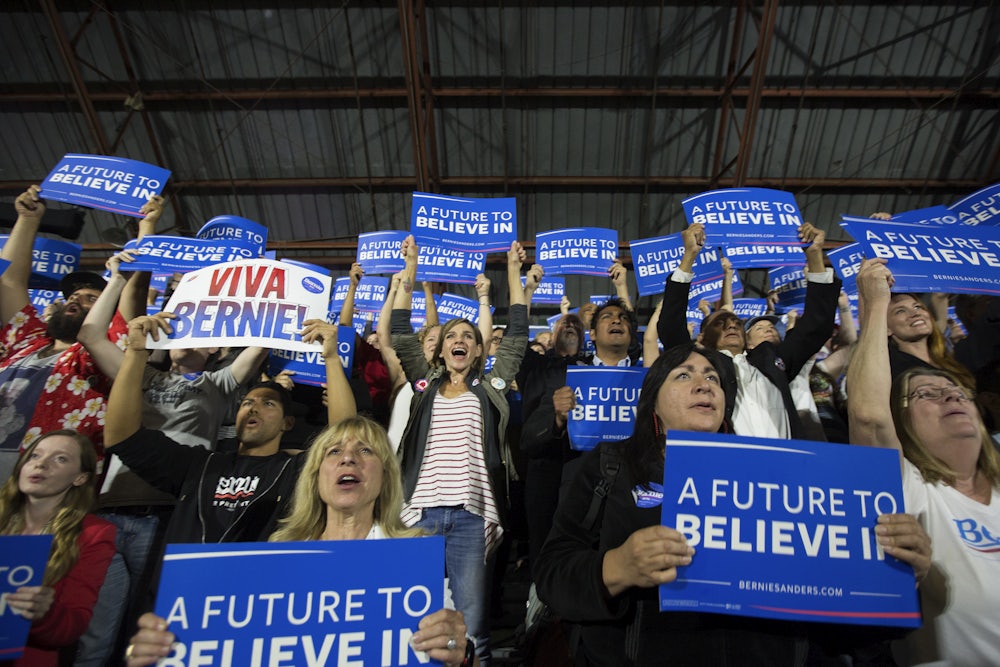Bernie Sanders, who was born in 1941 before the bombing of Pearl Harbor and the official American entry into World War II, is the oldest presidential candidate (still) in a race dominated by senior citizens, yet he’s made his mark as the youth candidate. Sanders’s major rival is only slightly younger than him (Hillary Clinton was born in 1947), but Sanders completely dominated with young voters in the primaries that officially concluded last night. Even Barack Obama’s legendary connection with young Democrats in 2008 pales in comparison: While Obama won 60 percent of their vote in that primary season, Sanders captured 71 percent eight years later. And he did it by running on the most explicitly economically progressive presidential campaign since at least George McGovern in 1972, or perhaps even Henry Wallace in 1948.
Although Sanders is winding down his campaign, he’s likely to cast an unusually large shadow for a losing candidate, and the reason can be summed up in one sentence: He mobilized a large left-wing youth vote that will dominate the Democratic Party and shape a generation’s political aspirations for years to come.
Clinton seems to be very cognizant of Sanders’s impact—and she really has no choice. In her historic speech last Tuesday when she became presumptive nominee of the party, she said all the usual magnanimous things about Sanders—that “he has spent his long career in public service fighting for progressive causes and principles, and he’s excited millions of voters, especially young people,” and so on. But you could hear Sanders’s influence most unmistakably when she wound down her tribute by sounding nothing like the old, cautious, let’s-find-middle-ground Clinton: “Senator Sanders, his campaign, and the vigorous debate that we’ve had about how to raise incomes, reduce inequality, increase upward mobility have been very good for the Democratic Party and for America. ... We all want an economy with more opportunity and less inequality, where Wall Street can never wreck Main Street again.”
The impact that Sanders has had on Clinton can be seen not just in the sharper class angle of her denunciations of Wall Street, but also her reversals on the Trans-Pacific Partnership and the Keystone XL Pipeline, as well as her increasing receptiveness to raising the minimum wage to $15 and expanding health care coverage to allow people to, she now says, “buy into Medicare at a certain age.” And it’s not just Clinton who has been pulled to the left: President Obama’s coming out in favor of expanding Social Security recently would have been unthinkable if not for the way Sanders has proven there is a receptive audience for progressive economic policy.
By tugging Clinton to the left, Sanders was doing her a huge favor—one that may very well help her win in November, and that will make her presidency, if she wins, likely far more consequential. Sanders pulled her in the direction her party, and especially its youngest voters, were already heading—but where cautious Clinton wasn’t guaranteed to move without a big push. A poll released earlier this year by Pew indicated how much Democrats have moved left just since Clinton’s first run for president:
In 2015, more Democratic voters identified as liberals (42%) than as moderates (38%) or conservatives (17%), based on an average of Pew Research Center political surveys conducted last year. In 2008, when Barack Obama defeated Clinton for the party’s nomination, 41% of Democratic voters called themselves moderates, while just 33% said they were liberals and 23% said they were conservatives. And in 2000, moderate Democratic voters outnumbered liberals by 45% to 27%.
It was these increasingly liberal voters who provided the backbone of the Sanders movement. Sanders has been the gateway through which young liberals have entered the party (and much of their frustration with the rules and regulations was the natural clash between newcomers and long-time Democrats). By taking the inchoate economic frustrations of this millennial cohort and finding ways to channel them into democratic socialist policies, Sanders has shifted the equilibrium within the Democratic Party—and American politics writ large.
Clinton, like her husband, is an instinctive triangulater, someone who has always positioned herself smack dab in the middle of where the Democratic Party is. But that middle spot isn’t fixed. Thanks to Sanders it has moved markedly to the left—a trend that will likely continue as Sanders voters rise in the ranks of the party and replace their elders. It’s possible that Sanders could bow out this week, but he can look back to his primary run as having been transformative.
Bernie Sanders won’t ever be president, but he joins the small, elite group of political figures who have changed American politics as much as any resident of the White House even without ever becoming commander-in-chief. Losing candidates can also re-configure politics, as Barry Goldwater and Jesse Jackson showed. Goldwater was buried in an electoral avalanche in 1964, but his campaign made the conservative movement the dominant wing of the GOP and prepared the groundwork for the ascent of Ronald Reagan. Jackson didn’t win the Democratic nomination, but his model of a Rainbow Coalition (made up of minority groups, feminists, the young, and LGBT people) prefigured the Obama coalition more than the old-school liberalism of Walter Mondale or the technocratic politics of Michael Dukakis.
Just as Goldwater paved the way for Reagan and Jackson for Obama, Sanders will shape future Democratic administrations, perhaps as early as next year if Clinton wins. He’s made Clinton a better candidate, and he’s transformed the sense of possibilities among progressives. Sanders’s message all along was: Don’t settle. Don’t believe that the partisanship and big money and Democrats’ compromises and perpetual gridlock means that we can’t still make huge, sweeping change happen. He’s lifted the sights of young progressives, and that will continue to move the party—and, most likely, a President Clinton—for years and decades to come.
